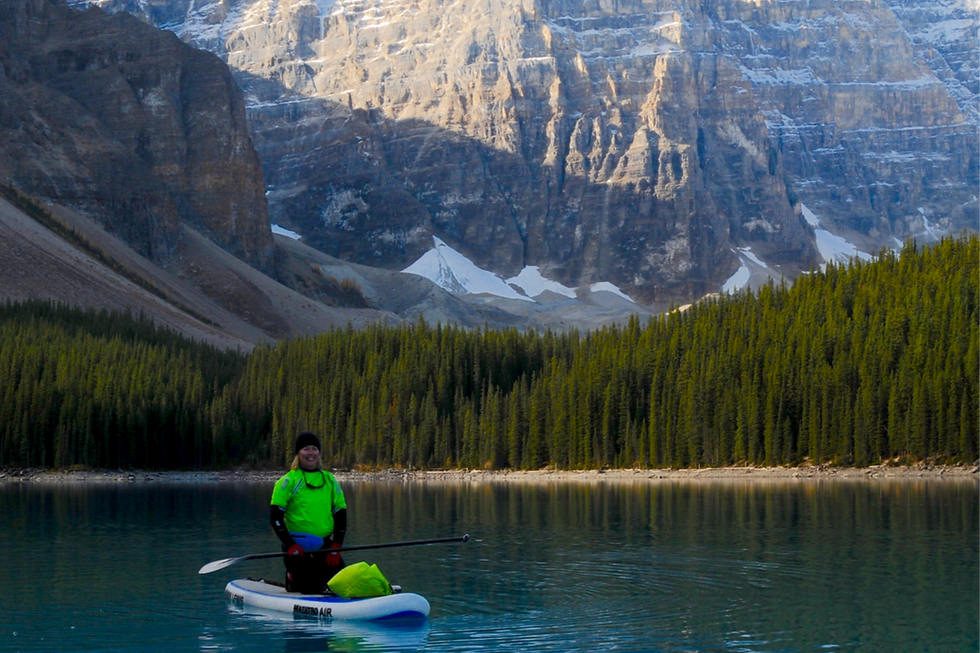How to Down Wind Paddleboard: The Beginner’s Guide
- Pam Martin

- Jan 24, 2023
- 4 min read

Downwind paddleboarding, also known as down winding, is a fun and exciting style of paddleboarding. It involves catching the wind and riding waves almost like surfing, but instead of catching a swell like surfing, you are riding the little surface waves created by the wind. Down winding requires a shuttle so you can start upwind and end downwind.
In this post, we will cover conditions to consider when down winding, paddle techniques for how to paddle downwind and how to run a shuttle.
Paddleboarding in the wind can be challenging especially for beginners if you're new to paddleboarding check out our Beginners Guide to Paddleboarding. With the right techniques and equipment, you will be able to master this exciting sport in no time.
Before you start, it's important to have the right equipment to be safe and prepared.
If you are unsure of what to wear check out our blog on What to Wear While Paddleboarding.
Not sure what paddleboard you will need to properly padle down wind? Check out our blog post on the Different Styles of Paddleboards.
Optimal Downwinding Conditions
When down winding, the skillset required is distinct from that of paddle surfing. You use the wind and waves to move forward while controlling your board with the paddle. The main concept is to keep your board facing downwind so you aren't fighting against it, and to try your best to not take the waves side on. It's also important to take note of which way the wind is blowing and if you will be able to safely get back to shore.
But all things considered, once you understand how to assess the conditions and create a plan to safely downwind paddleboard, it's a pretty unique and exciting way to improve your paddleboarding skills.
If you're uncertain about the wind while paddling, our blog post Paddleboarders' Guide to Wind Conditions is a great starting point. Reading this guide will help you make the right choices to ensure your paddleboarding experience is a quality one.
A good wind speed for paddleboarding is around 12 - 15 knots (22-28 Km/h). Anything above 20 knots (40km/h) is not considered a safe wind speed for paddle boarding.
However, it's essential to note that wind speeds vary depending on your location and weather, so be sure to check your local forecast or your favourite paddleboarding apps before heading out. Be aware of any potential hazards such as docks, rocks or other boats, and other paddlers while out in windy condiconditionstion as their potential hazards are much higher in the choppy waters.
Down Wind Paddle Strokes

When paddleboarding in windy conditions, there are a number of paddle strokes that will help you maintain control and stability on your board. Each of these strokes can be used to maneuver your board in different ways.
Here are a few of the best paddle strokes for windy conditions:
The forward stroke: This is the most basic and commonly used paddle stroke. It involves digging the blade of your paddle into the water at the nose of your board and pulling back to your feet, then releasing it to move forward. This stroke is used to build speed and move in a straight line.
The draw stroke: This stroke is used to move your board to the side. It involves digging the blade of your paddle into the water on one side of your board, then pulling the paddle back towards you. This stroke can be used to avoid objects or pull up beside your buddy.
The sweep stroke: This stroke is used to stabilize your board and make subtle adjustments in direction. It involves digging the blade of your paddle into the water on one side of your board, then sweeping it in a wide arc to move the board slightly to the side. This stroke is useful for maintaining control in windy conditions.
It's key to practice these strokes before heading out in windy conditions and having a trainer can dramatically improve how fast you master these strokes. Pam has training and lessons that can help prepare you for windy conditions if you need some guidance.

When dealing with too much wind while downwind paddleboarding, there are a few ways to manage it. One way is to angle your board into the wind, which will help you maintain control and move forward. Another way is to paddle harder and faster, which will help you build speed and stay stable.
In conclusion, downwind paddleboarding is a fun and exciting way to explore the water. With the right equipment and techniques, you can master this sport and enjoy the thrill of riding the wind and waves.
How to Run a Shuttle
For downwinding, you will have a put-in (start) location and a take-out (end) location. Your route should be linear (along the coastline or edge of the lake) and have parking at both ends. You will need two vehicles or someone to pick you up.
To get started, load all your SUP gear in one car and take both cars to the take-out (end) parking. Park the empty car here. Put your keys safely into a dry bag.
Drive upwind to your put-in location. Gear up, and ensure you have both sets of car keys. begin paddling downwind toward your take-out location.
Once you arrive, your can either drive back to the put-in to get the other car (for gear needs/roof rack) or you can load the take-out car and pick up the put-in car on the way home.
Running a downwind shuttle is the same a running a downriver shuttle. We highly recommend you watch this Boat Shuttling Explainer video (with Bill Mason) to enjoy the possible complexities of shuttling.
Want to improve your downwind paddling skills?
Join us on a trip to the Magdalen Islands, a scenic archipelago off the coast of PEI!




Comments